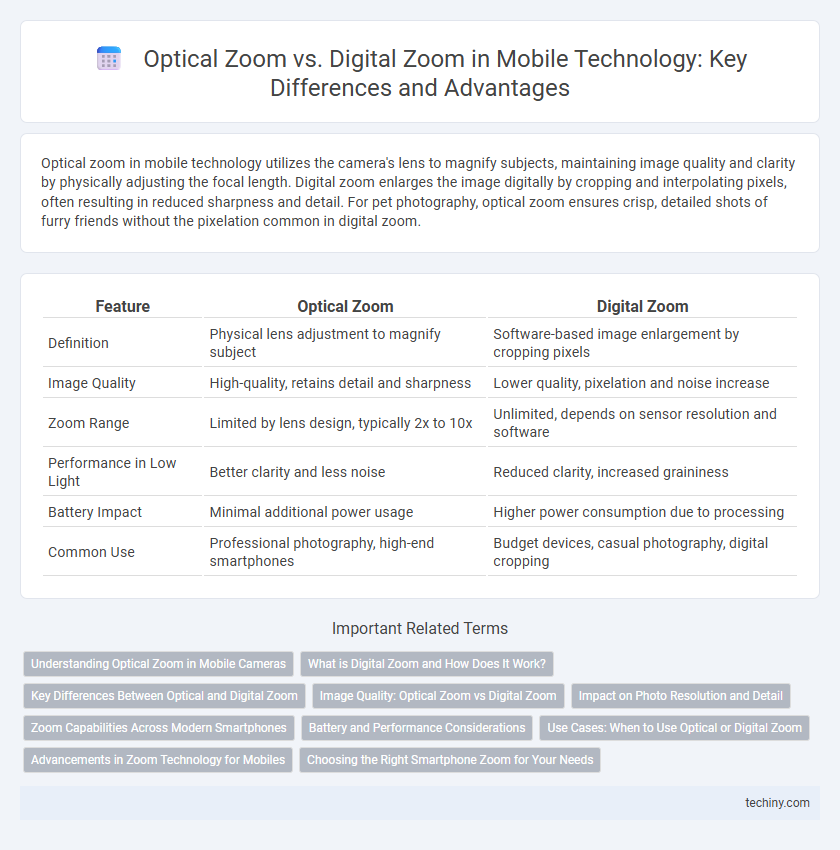Optical zoom in mobile technology utilizes the camera's lens to magnify subjects, maintaining image quality and clarity by physically adjusting the focal length. Digital zoom enlarges the image digitally by cropping and interpolating pixels, often resulting in reduced sharpness and detail. For pet photography, optical zoom ensures crisp, detailed shots of furry friends without the pixelation common in digital zoom.
Table of Comparison
| Feature | Optical Zoom | Digital Zoom |
|---|---|---|
| Definition | Physical lens adjustment to magnify subject | Software-based image enlargement by cropping pixels |
| Image Quality | High-quality, retains detail and sharpness | Lower quality, pixelation and noise increase |
| Zoom Range | Limited by lens design, typically 2x to 10x | Unlimited, depends on sensor resolution and software |
| Performance in Low Light | Better clarity and less noise | Reduced clarity, increased graininess |
| Battery Impact | Minimal additional power usage | Higher power consumption due to processing |
| Common Use | Professional photography, high-end smartphones | Budget devices, casual photography, digital cropping |
Understanding Optical Zoom in Mobile Cameras
Optical zoom in mobile cameras uses the lens's physical movement to magnify the subject, preserving image quality and detail even at higher zoom levels. Unlike digital zoom, which crops and enlarges the image digitally, optical zoom maintains clarity by adjusting focal length without pixel loss. This technology enables sharper photos and is crucial for capturing distant subjects with precision on smartphones.
What is Digital Zoom and How Does It Work?
Digital zoom enlarges a portion of the image by cropping and then interpolating pixels to fill the frame, resulting in reduced image quality compared to optical zoom. This technology relies on software algorithms to digitally magnify the image after it is captured by the camera sensor, rather than using lens movement. Mobile devices utilize digital zoom to simulate closer views when optical zoom mechanisms are limited or absent.
Key Differences Between Optical and Digital Zoom
Optical zoom uses the camera lens' physical movement to magnify the subject, preserving image quality by capturing more detail, whereas digital zoom enlarges the image digitally, often resulting in pixelation and reduced clarity. Optical zoom maintains resolution by adjusting focal length, while digital zoom crops and interpolates pixels, which can degrade sharpness. For mobile technology, optical zoom is preferred for high-quality zoomed photos, especially in smartphones with periscope lenses or advanced multi-element optical systems.
Image Quality: Optical Zoom vs Digital Zoom
Optical zoom uses the camera lens to magnify the subject, maintaining original image resolution and sharpness for superior image quality. Digital zoom enlarges the image by cropping and interpolating pixels, often resulting in reduced clarity and visible pixelation. For mobile technology, optical zoom is preferred for preserving detail and producing crisp photos, especially in low-light conditions.
Impact on Photo Resolution and Detail
Optical zoom preserves photo resolution and detail by using the camera lens to magnify the subject, maintaining image quality without pixel loss. Digital zoom, however, crops and enlarges the image digitally, leading to reduced resolution and visible pixelation. High-resolution sensors can partially mitigate digital zoom degradation, but optical zoom remains superior for capturing sharp, detailed photos.
Zoom Capabilities Across Modern Smartphones
Optical zoom in modern smartphones utilizes physical lens movement to magnify images without sacrificing clarity, delivering high-resolution zoomed photos ideal for detailed captures. Digital zoom relies on software algorithms to crop and enlarge images, often resulting in reduced image quality and pixelation. Comparing these technologies, flagship smartphones increasingly prioritize advanced optical zoom systems enabling up to 10x or greater optical magnification, whereas budget models primarily depend on digital zoom with compromises in sharpness and detail.
Battery and Performance Considerations
Optical zoom preserves image quality by physically adjusting lens elements, which demands more battery power and processing resources compared to digital zoom that crops and enlarges images electronically. Mobile devices using optical zoom often experience faster battery drain due to the motorized lens movement, while digital zoom relies heavily on the device's CPU and GPU, potentially impacting overall performance. Balancing battery life and photo quality requires understanding that optical zoom offers superior image clarity at the expense of higher energy consumption, whereas digital zoom conserves battery but may degrade image resolution.
Use Cases: When to Use Optical or Digital Zoom
Optical zoom is ideal for capturing high-quality images of distant subjects, such as wildlife or sports events, because it maintains image clarity by physically adjusting the lens. Digital zoom is better suited for cropping photos or videos after capture when fine detail is less critical, making it useful for quick social media sharing or casual snapshots. In professional mobile photography, relying on optical zoom ensures superior resolution and detail, while digital zoom offers convenience and flexibility for everyday use.
Advancements in Zoom Technology for Mobiles
Advancements in mobile zoom technology have significantly enhanced image clarity through improved optical zoom capabilities, utilizing sophisticated lens systems that magnify without losing detail. Modern smartphones combine optical zoom with advanced AI-powered digital zoom algorithms to extend reach while minimizing distortion and preserving image quality. These innovations enable users to capture distant subjects with high precision, bridging the gap between traditional optics and computational photography.
Choosing the Right Smartphone Zoom for Your Needs
Optical zoom uses the phone's physical lens elements to magnify images, preserving detail and image quality, making it ideal for capturing clear, high-resolution photos at a distance. Digital zoom enlarges the existing pixels by cropping and resizing the image, which often reduces quality and sharpness, suitable only for casual use or when optical zoom isn't available. When choosing the right smartphone zoom for your needs, prioritize devices with higher optical zoom capabilities for professional-grade photography and consider digital zoom for flexible, everyday snapshots.
Optical Zoom vs Digital Zoom Infographic

 techiny.com
techiny.com